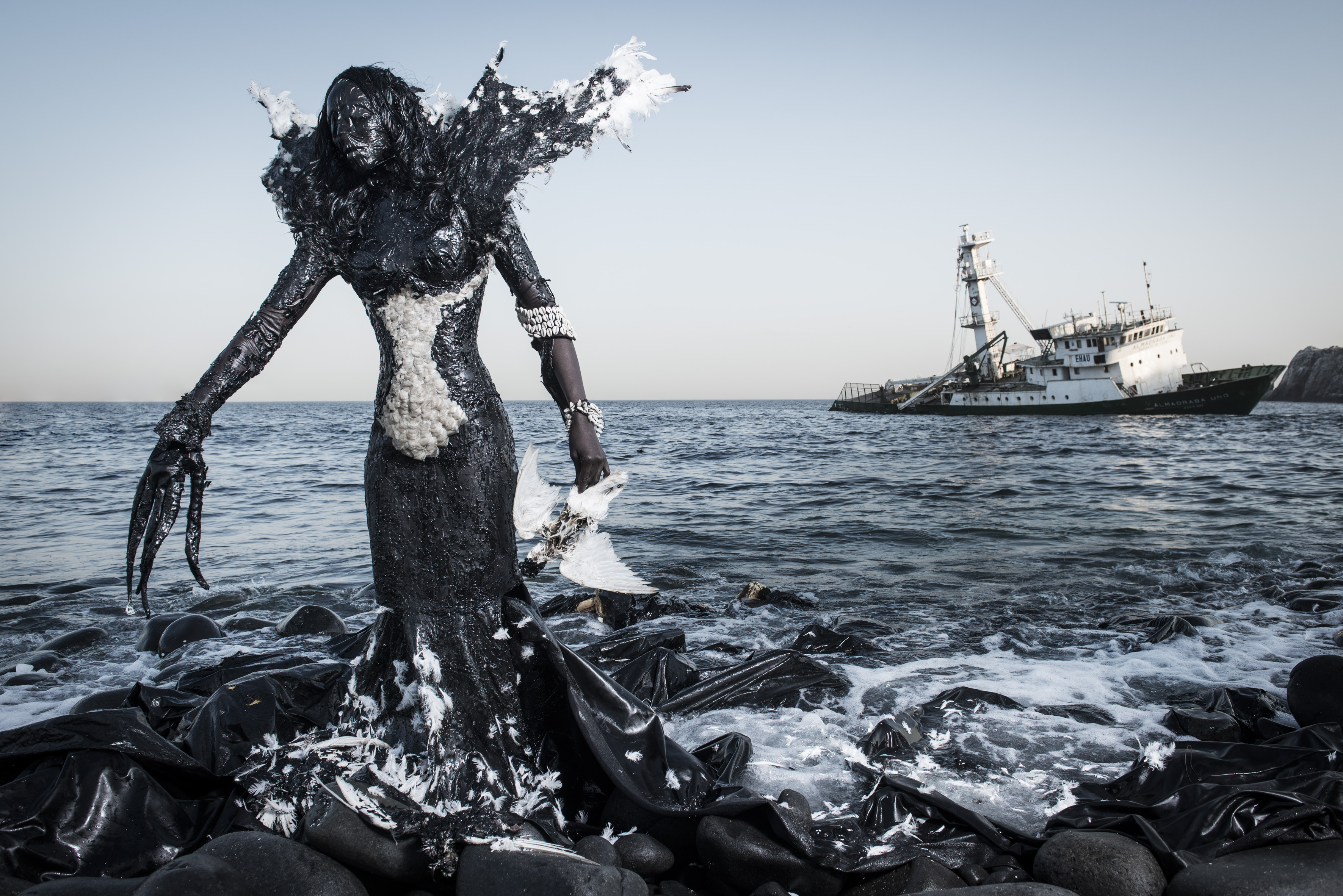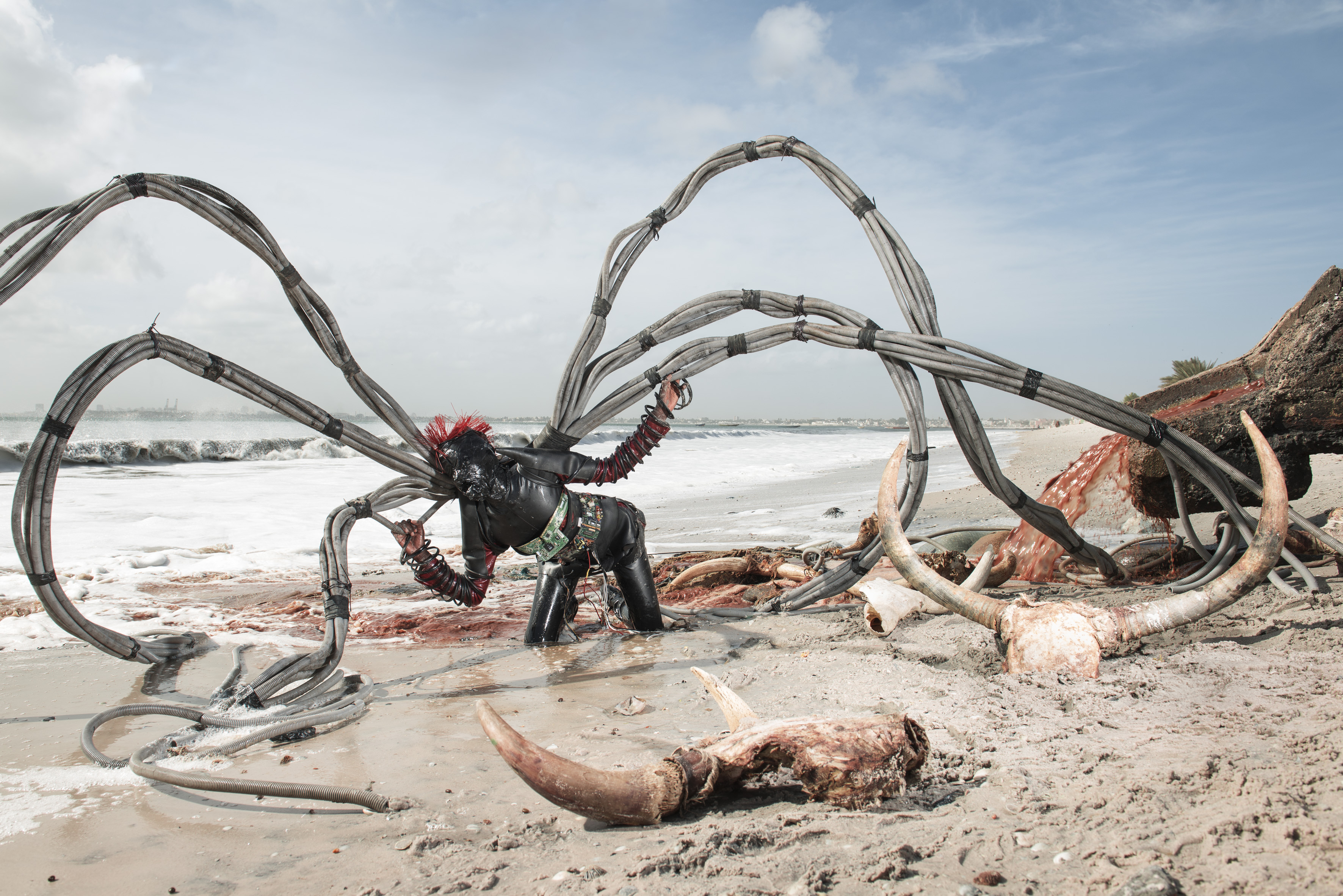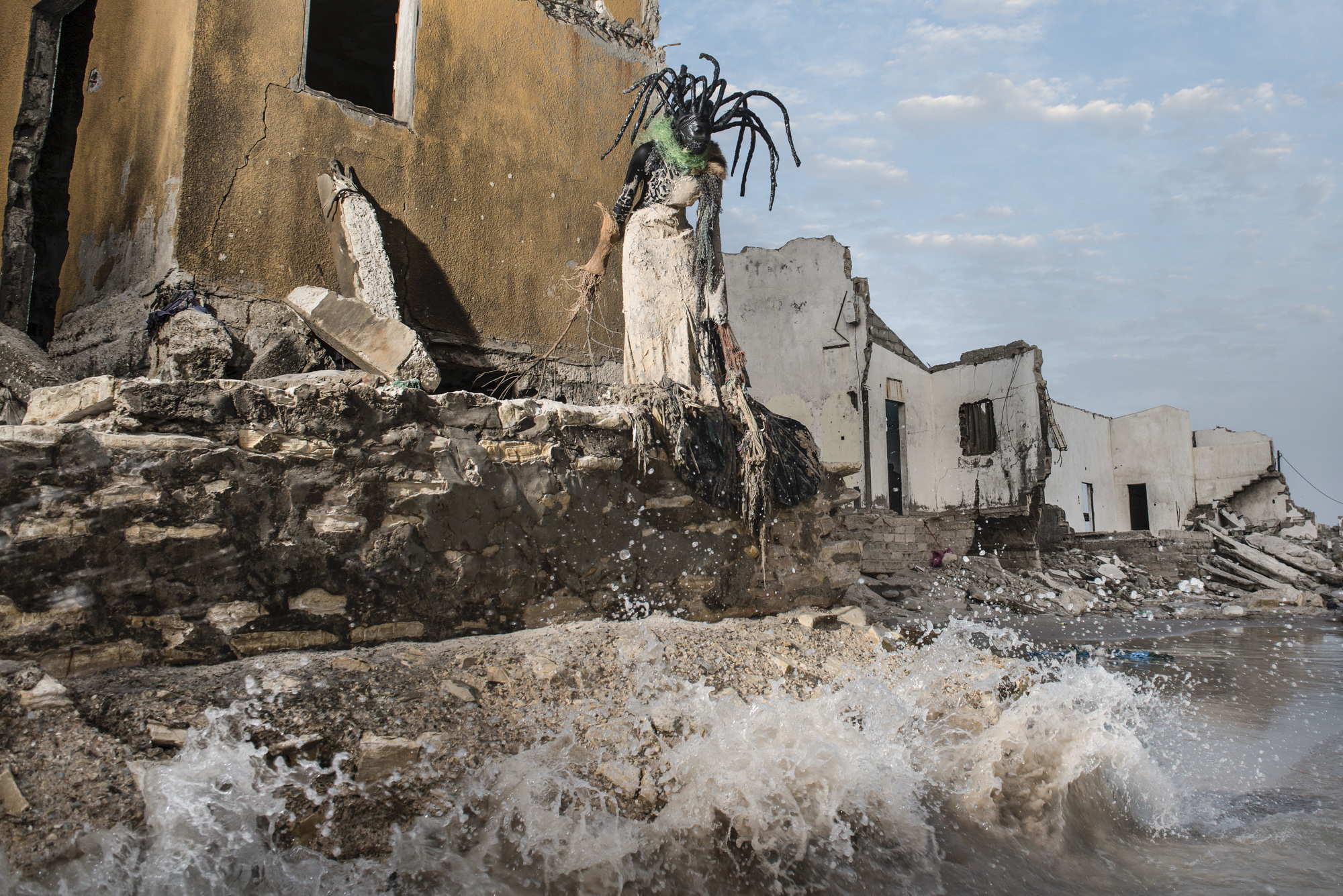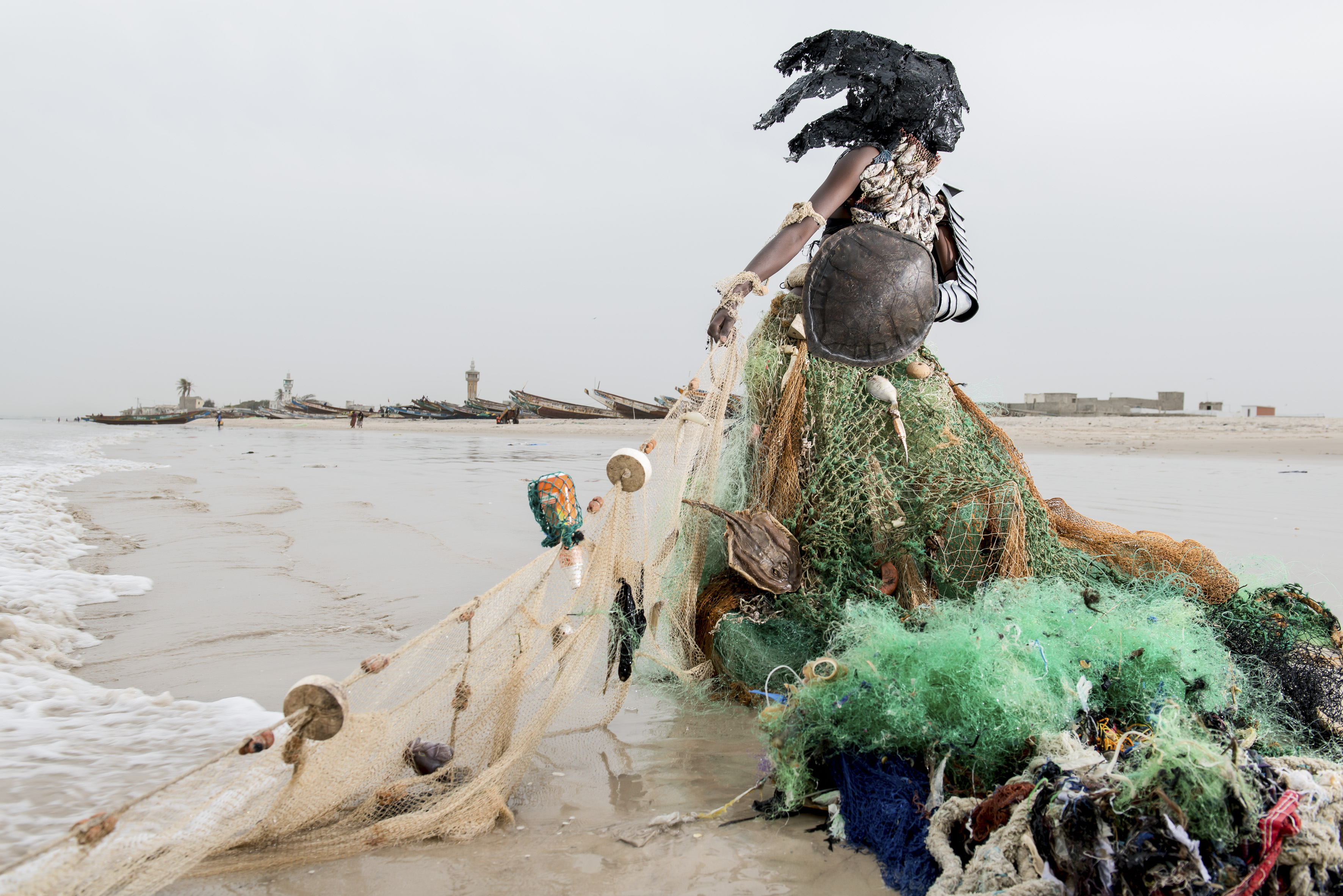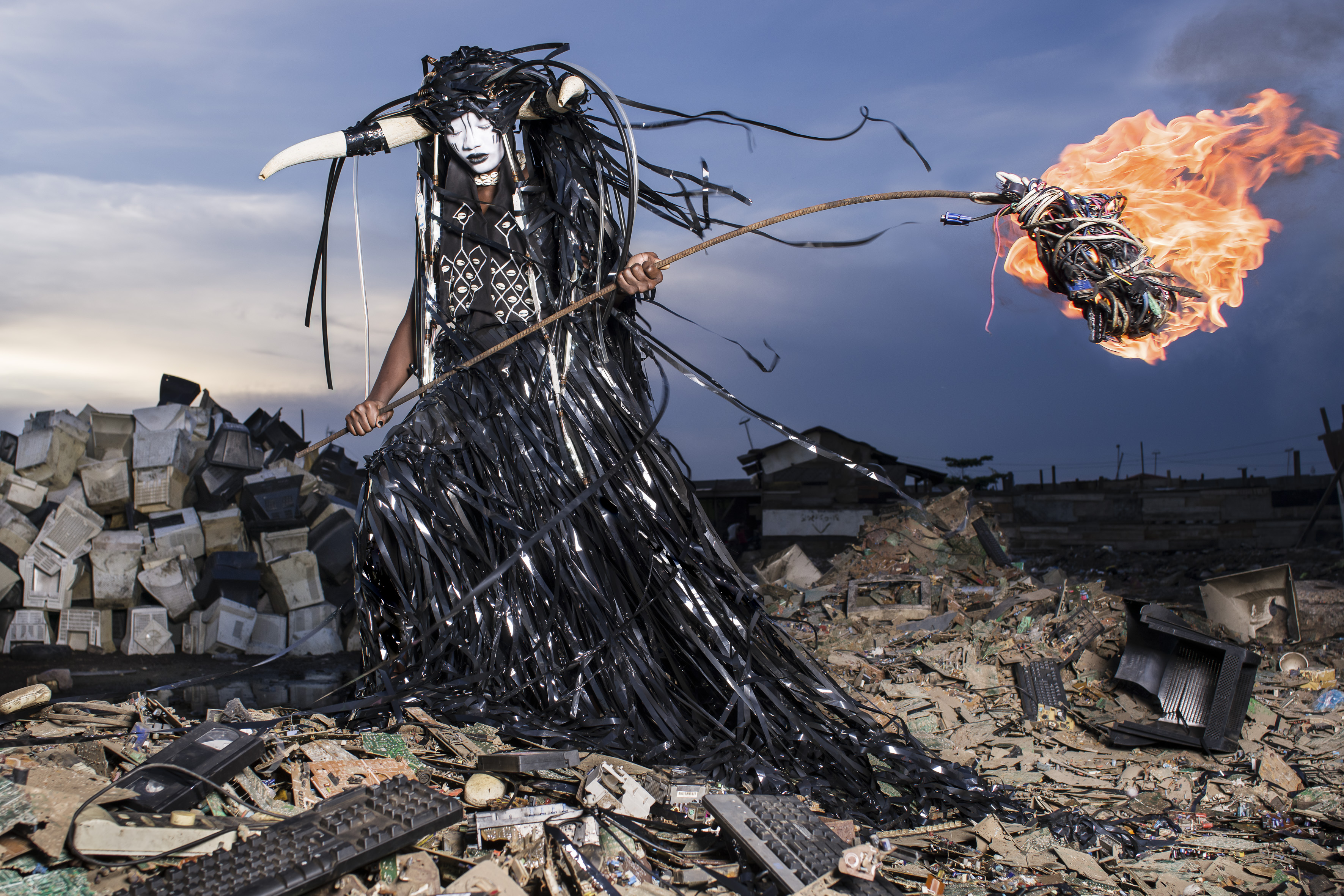Fabrice Monteiro (Belgian-Beninese, b. 1972)
This is what a human being can do to another human being in the name of nothing else but profit. And all the rest has been built up to justify the fact that you can use other human beings like you use animals in the fields.
–Fabrice Monteiro1
In Hesiod’s Theogony, Gaea, the ancient Greek goddess of the earth, gives life to the night sky, the ocean, the woodlands, and the mountains.2 She birthed the gods and “the ever immovable seat of all the immortals who possess snowy Olympus peak.”3 She then bore children with Ouranos, the sky, who hated these children, particularly the Hekatonkheires with their 100 arms and 50 heads, and the Titans, including Cronus: “For all these, who came forth from Earth and Sky as the most terrible of their children, were hated by their own father from the beginning. And as soon as any of them was born, Sky put them all away out of sight in a hiding place in Earth and did not let them come up into the light, and he rejoiced in his evil deed. But huge Earth groaned within, for she was constricted, and she devised a tricky, evil stratagem. At once she created an offspring, of gray adamant, and she fashioned a big sickle and showed it to her own children.”4 Like Ouranos trying to hide his children, corporations who create pollution often try to hide their waste, but as Beninese-Belgian photographer Fabrice Monteiro exposes in his works, that pollution will rise up and make itself known. Indeed, the bravest of Gaea’s children, Cronus, “took courage and addressed his cherished mother in turn with these words: ‘Mother, I would promise and perform this deed, since I do not care at all about our evil-named father. For he was the first to devise unseemly deeds.’”5 Unlike Cronus, however, with his devotion to Gaea, pollution will not remain loyal to the company that produced it.
Monteiro and Senegalese fashion designer Doulsy, who is behind the brand Jah Gal, weave ancient Greek mythology together with syncretized pre- and post-Islamic and Wolof traditions in Senegal to tell stories of its environmental catastrophes. In Prophecy #2, a jinnī made of oily sludge arises from Dakar’s Hann Bay, where a once-pristine fishing village is now polluted by the waste flowing from a slaughterhouse perched along the coast. Jinn are supernatural creatures that “delight in punishing humans for any harm done [to] them, intentionally or unintentionally, and are said to be responsible for many diseases and all kinds of accidents; however, those human beings knowing the proper magical procedure can exploit the jinn to their advantage.”6 Jinn do not embody typical monstrous characteristics—they are neither good nor bad by nature; rather, they take on the bidding of humans who know how to manipulate them. Corporate opportunism leads to environmental destruction. Monteiro’s compositions expose international corporations whose only responsibility is to make a profit and corrupt governments who see power and money before they see the needs of people.
This Hann Bay jinnī is constructed of a black plastic train that floats across the surface of the water, getting tangled in the rocks and suffocating the living ecosystem. On first view the bay may seem relatively pristine, but study the image long enough and it becomes apparent that the sea monster is holding a bird’s carcass. Toxic, the monster eats away at the wildlife that defines coastal culture, a metaphor for how the pollution of Hann Bay has public health, economic, and social implications beyond the destruction of the ecosystem. Living near water polluted with industrial waste is “strongly associated with the incidence of respiratory, dermatological, and gastro-intestinal problems.”7 Bays are naturally protected from the circulation and volatility of the open ocean, which is why they are perfect for fishing villages, but must also be protected against waste that cannot be processed or diluted because bays do not effectively drain out into anything. This is one reason why a Senegalese bay is a useful place to dump waste: rather than becoming an international scandal, a toxic cesspool forms around a place that does not have much of an international lens on it. Add to this natural feature an influx of population displaced from elsewhere in Senegal due to drought, a dearth of economic opportunities, and lack of infrastructure, all since independence in 1960, and further compounded by the establishment of over 100 industrial processing plants in the ensuing half-century.
The resulting pollution in Hann Bay itself is caused by residents who have no other place to dispose of their waste, and the runoff from these plants, which includes blood from slaughterhouses; oil dumped by food processing plants directly into the bay; and phosphoric acid from factories that process fertilizer. Commercial fishing companies also contribute to the pollution of the bay. Mbacké Seck8, waterkeeper, director of the Hann Baykeeper, and bay-adjacent Yarakh local, laments, “when we were kids, the beach was full of fine white sand … And there were so many fish that when there was a big wave, it could bring some of the fish to shore … And suddenly, we realized that it was impossible to swim in the bay … We noticed that there weren’t as many fish. And when the waves came in, there was just trash.”9 Doulsy’s fierce monster in Prophecy #8 is formed by a tangle of discarded fishing nets and protected by a shield of a dead sea turtle, likely suffocated by the polluted water, perhaps given to her by her mother Gaea. This monster confronts a commercial fishing industry that not only wipes out indigenous wildlife, but also local livelihoods.
Despite the specificity of the series, the ecological horror depicted is not just a Senegalese problem, or even an African problem.10 A VHS-tape cattle monster from Prophecy #11 brandishes her torch of cables atop a mountain of motherboards. This e-monster represents a global problem more so than the other images because this e-waste is not generated by Senegal, West Africa, or the African continent. Rather, e-waste is amassed by the Global North and shipped to Africa, either as waste or as refurbished products. The direct cause and effect of factories polluting a body of water in a local context is easy to see, but Western consumers play a key role in the environmental destruction of the Global South through our continuous consumption of technology. E-waste breaks down over time, leaching toxic chemicals into the land and water. Developing countries are particularly susceptible to the negative effects of e-waste because it has become common practice to ship used electronics to places “that lack the capacity to reject imports or to handle these materials appropriately…For example, there are problems with open-air burning and acid baths being used to recover valuable materials from electronic components, which expose workers to harmful substances. There are also problems with toxic materials leaching into the environment. These practices can expose workers to high levels of contaminants such as lead, mercury, cadmium and arsenic, which can lead to irreversible health effects…”11 Because the Global North is able to hide their consumption by shipping their waste across the ocean or through aspirational recycling, there is a disconnect that prevents changing habits. This is what makes Monteiro’s prophecies so powerful.
This cycle of consumption and subsequent pollution creates a global ripple effect with further-reaching ramifications. This series lays bare that destructive forces are not effectively harnessed by their creators, and the increasingly futile attempts to control resources just replicate ad infinitum. If one continues reading Theogony the cycle continues when Cronus is eventually deposed by his son, Zeus, during the battle between the Olympian gods and the Titans, after Cronus realizes that he is vulnerable in the same way his father was. Zeus, then, of course, becomes his own kind of monster.
Notes
-
Fabrice Monteiro, “Alpha Crucis — Contemporary African Art,” interview, Astrup Fearnley Museet, July 17, 2020, video, 7:52, https://www.youtube.com/watch?v=Y0Ijmpsncuc. ↩︎
-
Journalist Zahra Jamshed writes that Gaea, the ancient Greek goddess of the earth, is “exhausted by her incapacity to maintain the natural cycles of the planet in front of new modes of life and consumption.” She thus deploys her children to warn humans of the damage they are doing and inspire them to restore the health of the planet. While I agree that Gaea provides conceptual and visual inspiration for Monteiro and Doulsy, I think the metaphor is stronger when situated within Hesiod’s account. Zahra Jamshed. “‘The Prophecy’: Photographer captures terrifying vision of future,” CNN, November 17, 2015. https://www.cnn.com/style/article/photographer-fabrice-monteiro-the-prophecy/index.html. ↩︎
-
Hesiod, Theogony. Works and Days. Testimonia, trans. Glenn W. Most (Cambridge: Harvard University Press, 2007), 117-118. ↩︎
-
Hesiod, Theogony. ↩︎
-
Hesiod, Theogony, 147-162. ↩︎
-
“Jinni,” in Encyclopedia Britannica, November 16, 2018, https://www.britannica.com/topic/jinni. ↩︎
-
Lewis, Jori, “Cleaning Up Muddy Waters: The Fight to Revive Senegal’s Hann Bay,” Environmental Health Perspectives 124, no. 5 (2016): A93. ↩︎
-
Lewis, “Cleaning Up Muddy Waters,” A94-A95. ↩︎
-
Monteiro also expanded the series to look at climate change and environmental destruction in different parts of the world, including Australia, North America, and South America. ↩︎
-
“Cleaning up Electronic Waste (E-Waste),” United States Environmental Protection Agency, accessed September 28, 2021, https://www.epa.gov/international-cooperation/cleaning-electronic-waste-e-waste. ↩︎
